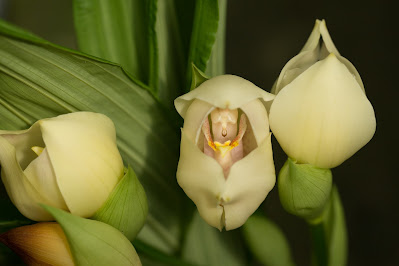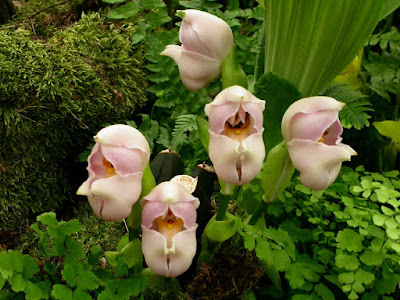Anguloa uniflora, also called as Swaddled Babies Orchid, The Single-Flowered Anguloa is found growing in deep shade and in deep leaf mold in...
Anguloa uniflora, also called as Swaddled Babies Orchid, The Single-Flowered Anguloa, Anguloa uniflora var. treyeranii, is a species of the genus Anguloa. This species was described by Hipólito Ruiz López and José Antonio Pavón Jiménez in 1798. It was named in honor of Don Francisco de Angulo, Director-General of Mines, in Peru.
IDENTIFY ANGULOA UNIFLORA - SWADDLED BABIES ORCHID
Anguloa uniflora is native to Central Peru. It is found growing in deep shade and in deep leaf mold in wet montane forests at elevations of 1400 to 2500 meters above sea level.
It is a large sized, robust, cool to cold growing terrestrial species which reaching 45-60 cm in height with clustered, generally dark green with a satiny surface, longitudinally grooved pseudobulbs that are enveloped basally by 3 to 5, smaller, leaflike sheaths and carrying 2 leaves. The green leaves are apical, plicate, elliptical.
Swaddled Babies Orchid blooms in summer until early fall (after the deciduous leaves fall) from the erect, 15 to 25 cm long, often 2, inflorescence with 5 to 7 graduated, inflated, large bracts with ovate, acuminate, subinflated floral bracts all arising basally as the new growths appear in the late winter. The flowers are unusually large in comparison to the size of the plant. These amazing flowers are often a creamish colour or completely white and are waxy in nature. Another interesting fact about these flowers is that they are extremely fragrant.
ANGULOA UNIFLORA - SWADDLED BABIES ORCHID CARE AND CULTURE
Cultural information should only be used as a guide, and should be to be adapted to suit you. Your physical location; where you grow your plants, how much time you have to devote to their care, and many other factors, will need to be taken into account. Only then can you decide on the cultural methods that best suit you and your plants.
Light:
Anguloa uniflora needs a light level of 25000-40000 lux, but should be protected from direct sun rays. Ensure good light levels in winter, as these are essential to encourage flowering so give as much light as you can without sunburn.
Humidity:
Swaddled Babies Orchid needs the humidity level of 70-80%. Too dry air has a negative effect on the development of the plant: its growth is inhibited, and the leaves begin to turn yellow and dry out. The higher temperature, the higher the humidity should be, and the higher the humidity, the more often and longer it is necessary to ventilate the room where the plants are contained, otherwise the probability of rotting and various kinds of fungal diseases.
If the humidity levels are consistently too low, consider buying a humidifier to increase the humidity level. Another way of increasing humidity is by setting your plants on trays filled with pebbles or gravel and with water, but plants should not be in contact with the water.
Temperature:
The Single-Flowered Anguloa can grow at summer days average of 22-25 °C, and nights average 17-19 °C, with a diurnal range of 5- 8°C. Winter days average 14-16 °C, and nights average 9-11 °C, with a diurnal range of 5-7 °C.
Substrate and growing media:
Anguloa uniflora grow best in plastic pots with drainage holes, you can also use clay pots. Use a mixture of bark and perlite, often with some charcoal or coarse peat as substrate. Plastic peanuts may be added for drainage.
Repotting should be done when a new growth is showing and during the temperate seasons, spring or fall. Depending on how often watering is required and your summer temperatures repotting should be done every 12-18 months. Young plants which are growing fast may become root bound much more quickly.
Watering:
Swaddled Babies Orchid need water when the plants are almost but not quite dry through the center of the pot. It is best to soak the potting mix thoroughly when you do water. In warm weather this can be as often as every 2-3 days and in the winter as little as once every 7-10 days.
Watering is directly dependent on the temperature of the content, the higher it is, the more often it needs to be watered. When watering, excess water should flow freely from the pot, since stagnation of water both inside the pot and in its pan can very quickly lead to rotting of the roots and the lower part of the plant.
Fertilizer:
The Single-Flowered Anguloa should be given a balanced, water-soluble fertilizer about once a month during the growing months. Do not feed plants when dormant (after leaves drop) until new growth is visible. It is best to under-fertilize rather than to over-fertilize. With the lower light and drier conditions in the home, the plant cannot use as much fertilizer as they can use in the greenhouse.
Rest period:
Anguloa uniflora need less water in the winter, especially if they grow under the conditions of a dark, short day that occurs at moderate latitudes. They should dry somewhat between waterings, but they should not be dry for a longer period. Frequent morning fogging and rare, economical watering should allow the plant to go through a dry period of rest, while providing it with sufficient humidity. Fertilization should be reduced or eliminated until new growths appear and a more abundant spring watering begins.















COMMENTS